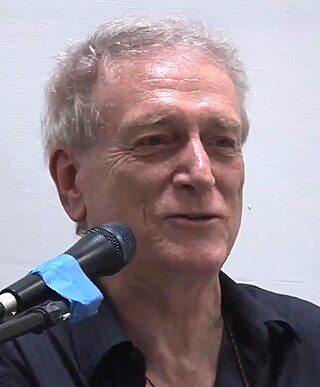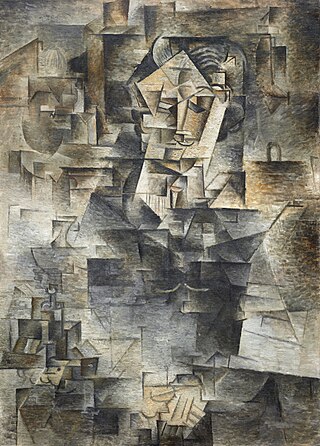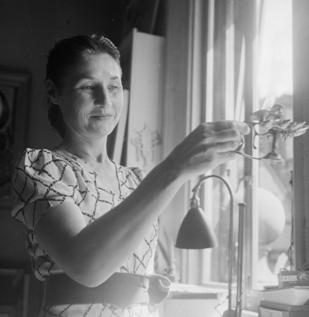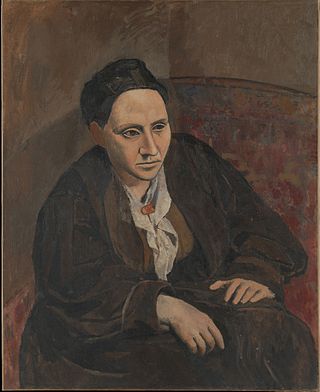
Pablo Ruiz Picasso was a Spanish painter, sculptor, printmaker, ceramicist, and theatre designer who spent most of his adult life in France. One of the most influential artists of the 20th century, he is known for co-founding the Cubist movement, the invention of constructed sculpture, the co-invention of collage, and for the wide variety of styles that he helped develop and explore. Among his most famous works are the proto-Cubist Les Demoiselles d'Avignon (1907) and the anti-war painting Guernica (1937), a dramatic portrayal of the bombing of Guernica by German and Italian air forces during the Spanish Civil War.

Gertrude Stein was an American novelist, poet, playwright, and art collector. Born in Allegheny, Pennsylvania, and raised in Oakland, California, Stein moved to Paris in 1903, and made France her home for the remainder of her life. She hosted a Paris salon, where the leading figures of modernism in literature and art, such as Pablo Picasso, Ernest Hemingway, F. Scott Fitzgerald, Sinclair Lewis, Ezra Pound, Sherwood Anderson and Henri Matisse, would meet.

Guillaume Apollinaire was a French poet, playwright, short story writer, novelist and art critic of Polish descent.

Jerome Rothenberg is an American poet, translator and anthologist, noted for his work in the fields of ethnopoetics and performance poetry.

Paul Blackburn was an American poet. He influenced contemporary literature through his poetry, translations and the encouragement and support he offered to fellow poets.

Sir Roland Algernon Penrose was an English artist, historian and poet. He was a major promoter and collector of modern art and an associate of the surrealists in the United Kingdom. During the Second World War he put his artistic skills to practical use as a teacher of camouflage.

Charles Henri Ford was an American poet, novelist, diarist, filmmaker, photographer, and collage artist. He published more than a dozen collections of poetry, exhibited his artwork in Europe and the United States, edited the Surrealist magazine View (1940–1947) in New York City, and directed an experimental film. He was the partner of the artist Pavel Tchelitchew.

Pierre Joris is a Luxembourg-American poet, essayist, translator, and anthologist. He has moved between Europe, North Africa and the United States for fifty-five years, publishing over eighty books of poetry, essays, translations and anthologies — most recently Interglacial Narrows and Always the Many, Never the One: Conversations In-between, with Florent Toniello, both from Contra Mundum Press. In 2020 his two final Paul Celan translations came out: Microliths They Are, Little Stones and The Collected Earlier Poetry (FSG). In 2019 Spuyten Duyvil Press published Arabia Deserta. Other recent books include: A City Full of Voices: Essays on the Work of Robert Kelly ; Adonis and Pierre Joris, Conversations in the Pyrenees ; Stations d'al-Hallaj ; The Book of U. His translation of Egyptian poet Safaa Fathy's Revolution Goes Through Walls came out in 2018 from SplitLevel. In June 2016 the Théatre National du Luxembourg produced his play The Agony of I.B.. Earlier publications include: An American Suite ; Barzakh: Poems 2000-2012 ; Breathturn into Timestead: The Collected Later Poetry of Paul Celan ; A Voice full of Cities: The Collected Essays of Robert Kelly and The University of California Book of North African Literature.
Samizdat was an international poetry magazine published in Chicago from 1998 until 2004 and edited by the poet Robert Archambeau. It was noted for its unusual format, being printed on large newsprint pages. Contributors included Adam Zagajewski as well as Clayton Eshleman, Pierre Joris, Jerome Rothenberg, Michael Heller, Stephen Collis, C.S. Giscombe, and others associated with experimental poetry. Eclectic and xenophilic in nature, the journal published work on or by Irish experimental poets, Eritrean poets, and new translations of poetry by Pablo Picasso and Paul Celan.
Exact Change is an American independent book publishing company founded in 1989 by Damon Krukowski and Naomi Yang who, outside of their publishing careers, were musicians associated with Galaxie 500 and Damon and Naomi. The company specialises in re-publishing 19th- and 20th-century avant-garde literature and has published works by John Cage, Salvador Dalí and Denton Welch among many others.

George Quasha is an American artist and poet who works across media, exploring language, sculpture, drawing, video art, sound and music, installation, and performance. He lives and works in Barrytown, New York.

The Weeping Woman is a series of oil on canvas paintings by Pablo Picasso, the last of which was created in late 1937. The paintings depict Dora Maar, Picasso's mistress and muse. The Weeping Woman paintings were produced by Picasso in response to the bombing of Guernica in the Spanish Civil War and are closely associated with the iconography in his painting Guernica. Picasso was intrigued with the subject of the weeping woman, and revisited the theme numerous times that year. The last version, created on 26 October 1937, was the most elaborate of the series, and has been housed in the collection of the Tate Modern in London since 1987. Another Weeping Woman painting created on 18 October 1937 is housed at the National Gallery of Victoria and was involved in a high-profile political art theft.

"If I Told Him : A Completed Portrait of Picasso” is a poem written by Gertrude Stein in 1923. It was first published in Vanity Fair in 1924 and she subsequently published it in her 1934 collection Portraits and Prayers. This poem was part of a multi-decade intertextual dialogue between Stein and Pablo Picasso. Stein was one of the first to exhibit Picasso’s paintings at her weekly salons at 27 rue de Fleurus. In 1906, Picasso completed a portrait of Stein, and the following year, she wrote her first literary portrait of Picasso, titled “Picasso.” Over a decade later, when the two were no longer working as closely together, she wrote this second portrait, notable for its non-representational style.

Farleys House near Chiddingly, East Sussex, has been converted into a museum and archive featuring the lives and work of its former residents, the photographer Lee Miller and the Surrealist artist Roland Penrose. It also houses a collection of contemporary art by their friends Pablo Picasso, Man Ray, Max Ernst and Joan Miró.

Portrait of Daniel-Henry Kahnweiler is an oil on canvas painting by Pablo Picasso in the Analytical Cubism style. It was completed in the autumn of 1910 and depicts the prominent art dealer Daniel-Henry Kahnweiler, who played an important role in supporting Cubism. The painting is housed in the collection of the Art Institute of Chicago.

27 rue de Fleurus was the home of the American writer Gertrude Stein and her partner Alice B. Toklas from 1903 to 1938. It is in the 6th arrondissement of Paris on the Left Bank. It was also the home of Gertrude's brother Leo Stein for a time in the early 20th century. It was a renowned Saturday evening gathering place for avant-garde artists and writers, notably Pablo Picasso and Ernest Hemingway.

Valentine Penrose, was a French surrealist poet, author, and collagist.

Portrait of Gertrude Stein is an oil-on-canvas painting of the American writer and art collector Gertrude Stein by Pablo Picasso, which was begun in 1905 and finished the following year. The painting is housed in the Metropolitan Museum of Art in New York. It is considered one of the important works of Picasso's Rose Period. The portrait has historical significance, due to the subject's role in Picasso's early life as a struggling artist and eventual commercial success. It also represents a significant transitional step in the artist's move towards Cubism.

Young Girl with a Flower Basket is a 1905 oil on canvas painting by Pablo Picasso from his Rose Period. The painting depicts a Parisian street girl, named "Linda", whose fate is unknown. It was painted at a key phase in Picasso's life, as he made the transition from an impoverished bohemian at the start of 1905 to a successful artist by the end of 1906. The painting is listed as one of the most expensive paintings, after achieving a price of $115 million when it was sold at Christie's on 8 May 2018. It is currently the fourth highest selling painting by Picasso.

Famille d'acrobates avec singe is a 1905 painting by Pablo Picasso. It depicts a family of travelling circus performers during an intimate moment. The work was produced on cardboard using mixed media: gouache, watercolour, pastel and Indian ink. It is held by the Gothenburg Museum of Art in Gothenburg, Sweden. The work was painted at a key phase in Picasso's life, as he made the transition from an impoverished bohemian at the start of 1905 to a successful artist by the end of 1906.



















